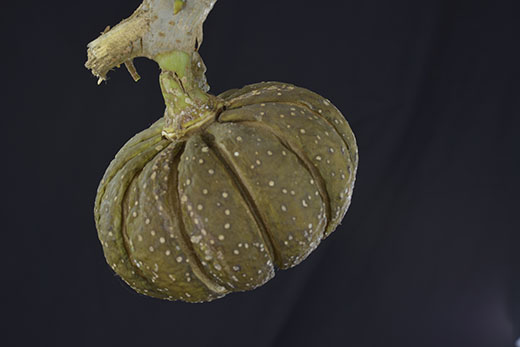Videos of exploding seed pods of Hura polyandra of Guatemala
Our search for the Hura polyandra tree was because images of a Hura species on Google showed impressive conical spines on the trunk. Conical spines are used by the ancient Maya to decorate their incense burners and some cache vessels. It is recognized that the inspiration for these conical spines in Maya art were the spines of the sacred Ceiba pentandra tree.
Hura polyandra Seed Pod.
But it turns out there are many other trees in Guatemala with spines (more than just Ceiba). These other species are worth studying since there are also “crocodile trees” pictured in proto-Maya Izapa stelae and in Early Classic Maya art. Crocodiles and caimans have spine-like protrusions along the top of their bodies. So it helps to study all trees of Mesoamerica which have conical spines or other rough surfaces on their trunks.
It took several years to find the elusive Hura polyandra trees and very quickly we noticed that the polyandra species had only very few spines; it was mainly Hura crepitans which had the frankly amazing conical spines everywhere on its trunk. But Hura crepitans is not known for Guatemala; it is further south.
In the meantime, even without conical spines, both Hura species have almost identical seed pods. These pods explode with a loud noise and throw their seeds many meters.
No one believes that any seed pod can explode with this violence, so we have begun to experiment. Our goal is to study the internal structure of the pod and hope that a student will do a thesis on the internal structure and how the pod explodes in milli-seconds.
We are experimenting with various manners to record this. Clearly our video equipment is rudimentary. Hopefully donations to our institute, FLAAR, will allow us to buy video equipment with stop-motion capability. The explosion of the pod is so fast that a normal digital SLR camera can’t stop the motion.
Here are first experimental videos. We hope you enjoy learning about the wonders of nature.
Videos
To select a video, just click on it's preview image, then just hit play.
First set of Videos
iPhone 5S
Canon 6D
Canon 6D
Second set of Videos
iPhone 5S
Canon 6D
Nikon D800
Third set of Videos
iPhone 5S
Canon 6D
Nikon D800
Fourth set of Videos
iPhone 5S
Canon 6D
Nikon D800
The pod must be dry to explode. We have found that shaking the pod vigorously may help trigger an explosion. Of course on the tree the wind would shake the pod, but there is no blunt force onto a pod up in a tree. Since we need to record the pod exploding, we can’t simply set a pod up with a video camera and wait….it could take weeks for the pod to explode. Actually three pods have exploded on their own, in the office, simply sitting on the floor (one we shook about 15 minutes before it exploded).
Different stages of the Hura polyandra Seed Pod.
But to have our video team recording the moment of explosion, it is not realistic to set up cameras, so we shake the pod and then hit it with a machete or a stick.
Warning: we do not recommend you try this yourself. The sap of the seed pod is toxic beyond belief. The explosion is violent (and loud). The sharp edges of the seed chambers could easily puncture your eyeball or otherwise wound and scar your body.
We are inherently curious, however, and wanted to experience the explosion in-person.
Pods harvested in early April; video in mid-April; video posted April 29, 2014.















































































